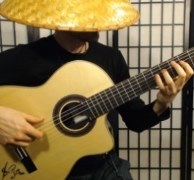Welcome to one of the most active flamenco sites on the Internet. Guests can read most posts but if you want to participate click here to register.
This site is dedicated to the memory of Paco de Lucía, Ron Mitchell, Guy Williams, Linda Elvira, Philip John Lee, Craig Eros, Ben Woods, David Serva and Tom Blackshear who went ahead of us.
We receive 12,200 visitors a month from 200 countries and 1.7 million page impressions a year. To advertise on this site please contact us.
|

|
|
Music theory
|
You are logged in as Guest
|
|
Users viewing this topic: none
|
|
Login  | |
|

   
mark indigo
Posts: 3625
Joined: Dec. 5 2007

|
 RE: Music theory (in reply to rombsix) RE: Music theory (in reply to rombsix)
|
|
|
IMO music theory is simple, but there are some problems to understanding or learning it.
One is that i understand music theory as a tool for explaining music practise, so trying to understand tritone inversions without hearing them or playing them is both difficult and pointless.
The second is that understanding something like tritone inversions depends on other knowledge, such as the knowledge of intervals and chords, so trying to understand the more complex stuff without a firm grasp of the basics is a major block to learning and understanding theory.
When someone tries to explain 11ths and 13ths and flat 5ths etc. to someone who doesn't understand scales, intervals, and triads etc. they are just not gonna get it!
Start with something like Cantiñas in C Major and learn about the scale and chords used.
If you understand a scale as a series of numbered intervals (1st, 2nd, 3rd etc.), and chords in those terms (1st, 3rd, 5th etc.), and that the chords in a key are build on and from the notes of the scale, then you can build up from there.
Once you understand how the basic C major works you can transpose all of that to G major and then round the rest of the clock to all the keys.
Understand triads first before adding 7ths. The same process of adding the 7th will then apply to adding the 9th, 11th, and 13th.
If you know the basic major scale intervals and chords you can go from there to sharping or flatting those intervals.
I was given Ralph Denyer's "Guitar Handbook" when i first had an electric guitar as a teen and didn't give it much of a look at the time, but later i got all of the theory stuff together out of that book.
|
|
|
|
REPORT THIS POST AS INAPPROPRIATE |
Date Jun. 20 2010 6:03:31
 |
|

   
gjbch
Posts: 14
Joined: May 26 2010
From: Nicaragua

|
 RE: Music theory (in reply to rombsix) RE: Music theory (in reply to rombsix)
|
|
|
Ahhh, music theory. I would be more than happy to answer any specific questions you (or anyone else) have with regards to this dense topic. I have a BA in music (focus on theory/composition), and am now going for a MA/Phd in composition, so you know where I'm coming from.
Broadly speaking, I have personally used music theory towards two distinct ends (assuming it's not an end in itself). 1) As a tool to analyze and objectively communicate about music, so you can understand, deconstruct (and recreate), and talk about what's going on in others' compositions. And; 2) as a way to inform your own compositions. I say "inform" because theory is just one of many tools at our disposal when writing music, and has led me to discover amazing new harmonies that would have been impossible (or highly improbable) to stumble upon by ear.
Also, be aware that music theory goes far beyond simply understanding common-practice tonal music. Since flamenco isn't strictly tonal, I would suggest beginning with the basics before jumping into tonal, modal or post-tonal theory, otherwise you might get confused because it might not line up exactly with the music you're analyzing.
For me, knowing intervals inside and out is the best foundation one can have for understanding more complex theory. Take the time to reallly really learn the basics, and everything else will go smoothly.
First, know the chromatic scale and enharmonic equivalents.
C C# D D# E F F# G G# A A# B C
C Db D Eb E F Gb G Ab A Bb B C
It's important to remember that only two natural half steps are between B C and E F. All the other notes have a sharp or flat between them.
Here are the INTERVALS within 1 octave relative to the note C
Unison = same pitch C to C (not an octave, but actually the same note!)
Minor 2nd = semitone C to Db
Major 2nd = whole step C to D
Minor 3rd = 3 semitones C to Eb
Major 3rd = 4 semitones C to E
Perfect 4th = 5 semitones C to F
Augmented 4th
Diminished 5th
Tritone = all three are the same interval: 6 semitones. C to F# or C to Gb
Perfect 5th = 7 semitones. C to G
Minor 6th = 8 semitones. C to Ab
Major 6th = 9 semitones. C to A
Minor 7th = 10 semitones. C to Bb
Major 7th = 11 semitones. C to B
Octave = 12 semitones. C to C'
The best way to conceptualize larger intervals (6ths and 7ths) is by their compound intervals, or the "remaining distance" between the note and the octave.
A minor 6th's compound interval is a Major third.
A Major 6th's compound interval is a minor third.
A minor 7th's compound interval is a Major second.
A major 7th's compound interval is a minor second.
So C - A is a sixth. Is it major or minor? The best way to find out is to look at A-C (the compound third). A - C is a minor third (because B-C is a natural half step). Since A-C is a minor third (it's slightly smaller), then C-A must be a Major sixth (slightly larger). Same goes for sevenths.
This idea of compound intervals is really helpful to think quickly - please let me know if you're already comfortable with this stuff and I can offer you some other topics to study (augmented and diminished intervals). Otherwise I'd be happy to clarify anything that's confusing or unclear.
Best!
Gabriel
Edit: it's also good to study theory both on and away from the instrument. I find actually writing it on paper (if you know how to read notation) the best way to conceptualize it.
Edit #2: I've just posted some basic concepts of music analysis here. It's in spanish, but I'll try to translate it in the next day or so.
|
|
|
|
REPORT THIS POST AS INAPPROPRIATE |
Date Jun. 21 2010 23:40:27
 |
|

  
XXX
Posts: 4400
Joined: Apr. 14 2005

|
 RE: Music theory (in reply to gjbch) RE: Music theory (in reply to gjbch)
|
|
|
quote:
ORIGINAL: gjbch
Ahhh, music theory. I would be more than happy to answer any specific questions you (or anyone else) have with regards to this dense topic.
Yep, i actually have and always wondered about this.
Why is it the circle of fifths and not of seconds, thirds, etc.. what makes the V-I resolution more special than others?
If there is a reason at all, besides the fact that we "are used to it".
Just red this, and a bit more explanation would be nice: "Also, be aware that music theory goes far beyond simply understanding common-practice tonal music. Since flamenco isn't strictly tonal, I would suggest beginning with the basics before jumping into tonal, modal or post-tonal theory, otherwise you might get confused because it might not line up exactly with the music you're analyzing."
_____________________________
Фламенко
|
|
|
|
REPORT THIS POST AS INAPPROPRIATE |
Date Jun. 23 2010 14:38:23
 |
|

   
gjbch
Posts: 14
Joined: May 26 2010
From: Nicaragua

|
 RE: Music theory (in reply to XXX) RE: Music theory (in reply to XXX)
|
|
|
quote:
Yep, i actually have and always wondered about this.
Why is it the circle of fifths and not of seconds, thirds, etc.. what makes the V-I resolution more special than others?
If there is a reason at all, besides the fact that we "are used to it".
This is a great question, and pretty complex. There are many explanations for this, some of them very dense, but the simplest way to put it is because of the leading tone (the seventh scale degree in a major scale, or the raised seventh in a minor scale). In C major, the leading tone is the note B – this note has the strongest need/desire to resolve up to C, and if it doesn’t it could sound unresolved. This is something composers work with a lot: it’s fun to play with expectations like this.
Try playing an ascending C major scale on the guitar, and end the scale on a B. It’ll sound unresolved, like we were just left hanging. This is what I mean by having a strong need for the note B to resolve up to C.
So if you analyze a V – I progression note-by-note you’ll see other similar relationships, albeit less powerful, that add to the overall sense of resolution going from V or V7 to I.
A V7 – I resolution in C major:
G B D F – C E G
The G is a common tone, creating continuity between the two chords.
The B resolves up to a C.
The D resolves down to a C (some people argue it resolves up to an E, but I personally don’t hear it that way. This is rather subjective, though).
The F resolves to the E.
So each of the notes of the G7 chord want to resolve to each of the notes in a C chord, creating a very powerful harmonic relationship. But like I said, the leading tone – tonic relationship (B resolving to C) is actually what makes it such a strong resolution.
A diminished 7th chord (B D F A in the key of C major) can be substituted for a V7 chord. Notice they have all but one note in common – the G is now an A. So actually the vii dim – I relationship is nowadays just as powerful as the V-I, and sounds much less corny imo.
The reason ii chords don’t tend to want to resolve to I is because:
D F A – C E G
There is no leading tone in a ii chord. If anything, the ii wants to resolve to the V:
D F A - G B D
They have D in common, the F resolves up to G and the A down to G (or up to B).
The reason iii chords don’t tend to want to resolve to I is because:
E G B – C E G
Notice they have 2 out of three notes in common – the only difference is the note C or B. This means they have very similar harmonic function, and you can actually use them as substitutions (ie: substitute an E minor chord for a C major chord, or vice-versa). When chords are harmonically this similar, there is a sense of harmonic continuity or harmonic extension (the harmonic function is prolonged) rather than a sense of harmonic change (like a resolution.)
The circle of fifths is just a handy shortcut for figuring out how many sharps or flats each key has. It happens that keys separated by a fifth (ie: the key of C major or G major) have all but one note in common (in this case, F or F#).
quote:
Just red this, and a bit more explanation would be nice: "Also, be aware that music theory goes far beyond simply understanding common-practice tonal music. Since flamenco isn't strictly tonal, I would suggest beginning with the basics before jumping into tonal, modal or post-tonal theory, otherwise you might get confused because it might not line up exactly with the music you're analyzing."
A solea, for example, is played in E Phrygian with a sharp 3rd (E F G# A B C D E). While they are the exact same notes as a melodic A-minor scale (A B C D E F G# A), they are not synonymous! We would have to analyze the piece in the context of E Phrygian mode rather than do a tonal analysis based around A minor.
The “tonic” chord in this case is E major – this is when the solea is at rest, when there is relatively little harmonic tension, when everything has resolved (use your ears). If you were analyzing this tonally (in the context of A minor rather than E Phrygian), you would say that the E major chord is the dominant, and so wants to resolve to the A, which is definitely not the case when you hear a solea. This would be an example of how a tonal analysis falls short of what is actually occurring. In this sense, a solea is not a tonal piece of music, but rather somewhere between tonal and modal.
Taking it one step further, the “dominant” function in a solea would be the F major (or even F maj7) chord, because this harmony has a very strong tendency to want to resolve down to E. People would never call F the dominant because it would be far too confusing, but from a purely practical and functional harmonic perspective it serves the same exact function as a V harmony. Notice the half-step between E and F acts somewhat like a reverse leading-tone in tonal music. The note F resolving down to E is what makes this such a powerful harmonic relationship.
Try playing a descending E phrygian scale and end on F - it will sound just as unresolved as the C major scale ending on B.
But on the other hand, Alegrias are usually more tonal than not, and analyzing them tonally would work just fine.
|
|
|
|
REPORT THIS POST AS INAPPROPRIATE |
Date Jun. 23 2010 18:01:02
 |
|

   
Ricardo
Posts: 14806
Joined: Dec. 14 2004
From: Washington DC

|
 RE: Music theory (in reply to gjbch) RE: Music theory (in reply to gjbch)
|
|
|
quote:
The circle of fifths is just a handy shortcut for figuring out how many sharps or flats each key has.
It is much more then that. It may also be used to describe any modulations within a key or single piece. It can also reveal proper chord scale relations, and describe any music really that uses the guitar or piano. Even modes and relations between them is understood on the circle.
quote:
People would never call F the dominant because it would be far too confusing, but from a purely practical and functional harmonic perspective it serves the same exact function as a V harmony.
Actually, if it were not for rhythmic phrasing, all of the phrygian palos fall under the scope of what would be normal minor key analysis. (Meaning the way the chords and associated scales function the same....a mix of A natural minor, A harmonic minor, A melodic minor, all available to a piece in E phrygian flamenco like Solea or fandangos).
Many musicians not familiar with the rhythmic concepts of flamenco would not only analyze the E chord as V7, but hear it as well as the V7, meaning the music is left unresolved. Many Granainas often resolve to what would be minor i (E minor via B7), allowing say a classical theory student to analyze the entire piece as in E minor not B phrygian.
The thing about your F chord not being dominant. Well actually you skipped the common usage of F7->E. (FACEb-EG#B) That falls under the classical tonal harmony scope or "augmented 6th chords". Which itself is a bit of a circle of 5th rule breaker (enharmonic misspelling of the D# rather then Eb making D#FAC) but still understood as normal tonal harmony in key of A or A minor, MINUS the resolution to Aminor....again "hanging on the V".
For me, flamenco is simply a hybrid of modal and tonal concepts, yet because of the tuning, the idea of equal tempered 12 note chromatic scale of the guitar, pretty much all the harmonic and melodic aspects of flamenco also falls within the scope of the circle of 5ths and tonal harmony explanations.
Rhythmic concepts are another world though, and greatly influence the way one should analyze flamenco harmony.
quote:
i think the G/G# issue is easy in practise (ie. when playing solea!) but tricky to explain in theory terms, anyone else?
Not really. The same thing happens in classical music in the key of A minor. Both notes and chords are used. Only G# when you have the E harmony. The G chord to C chord functions the same in A minor as in E phrygian, Dm7-G7 same deal, etc, all the same. Only difference is RESTING on E is weird unless you understand the rhythmic phrasing...the compas. Hope that makes sense. Examine a bulerias in A minor vs on in E phrygian to see what I mean.
Ricardo
_____________________________
CD's and transcriptions available here:
www.ricardomarlow.com
|
|
|
|
REPORT THIS POST AS INAPPROPRIATE |
Date Jun. 24 2010 21:20:01
 |
|
 New Messages New Messages |
 No New Messages No New Messages |
 Hot Topic w/ New Messages Hot Topic w/ New Messages |
 Hot Topic w/o New Messages Hot Topic w/o New Messages |
 Locked w/ New Messages Locked w/ New Messages |
 Locked w/o New Messages Locked w/o New Messages |
|
 Post New Thread
Post New Thread
 Reply to Message
Reply to Message
 Post New Poll
Post New Poll
 Submit Vote
Submit Vote
 Delete My Own Post
Delete My Own Post
 Delete My Own Thread
Delete My Own Thread
 Rate Posts
Rate Posts
|
|
|
Forum Software powered by ASP Playground Advanced Edition 2.0.5
Copyright © 2000 - 2003 ASPPlayground.NET |
0.078125 secs.
|


 Printable Version
Printable Version



















 New Messages
New Messages No New Messages
No New Messages Hot Topic w/ New Messages
Hot Topic w/ New Messages Hot Topic w/o New Messages
Hot Topic w/o New Messages Locked w/ New Messages
Locked w/ New Messages Locked w/o New Messages
Locked w/o New Messages Post New Thread
Post New Thread